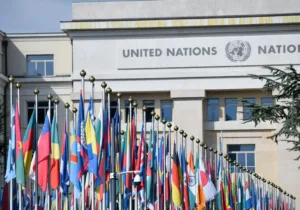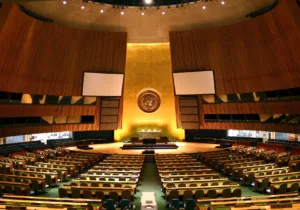In a fit of libertarian anarchism, a youthful Edmund Burke penned A Vindication of Natural Society (1756), wherein he boldly asserted, “Political Society is justly chargeable with much the greatest Part of the Destruction of the Species…[for] it is an incontestable Truth, that there is more Havock made in one Year by Men, of Men, than has been made by all the Lions, Tygers, Panthers, Ounces, Leopards, Hyenas, Rhinoceroses, Elephants, Bears, and Wolves, upon their several Species, since the Beginning of the World.” Burke’s destructive “Political Society” is what would today be termed the state; and in Red Famine: Stalin’s War on Ukraine, journalist, author, and thoughtful resistance figure Anne Applebaum conclusively demonstrates that the beleaguered inhabitants of independent Ukraine (1918-) have always had to fear human affliction much more than even the formidable environmental challenges of civilization on the Eurasian steppe. The acclaimed author of Gulag: A History (2003) and Iron Curtain: The Crushing of Eastern Europe (2012) has most recently turned her attention to the Holodomor, the Ukrainian “hunger annihilation” of 1932-33 that resulted in four million unnecessary deaths, but which was for many years denied or disregarded by the outside world.
The worst famine in European history, the apocalyptic Holodomor that climaxed in the spring of 1933 resulted primarily from Stalin’s exhaustive expropriation of Ukrainian grain and accompanying terrorization of the Ukrainian peasantry, both the work of the OGPU secret police and their local collaborators. During this interval, the Ukrainian countryside experienced horrors evocative of Biblical catastrophe: starving adults who expired amid their daily routine, parents determining which of their offspring must perish so that the others might live, and solitary children abducted and killed for nourishment. This ghastly history was depicted in the influential documentary Harvest of Despair (1985), and the following year in Robert Conquest’s Harvest of Sorrow (1986), but Applebaum takes up the question with fresh decision, advancing three main arguments.
First, she is keen to establish merely that the Holodomor occurred. The Soviet Union until its end officially denied all knowledge, beginning when Stalin shot the overseer of the 1937 census (301). More importantly, Soviet propaganda, control of information, and the self-delusion of left-wing intellectuals in the West largely ensured that critical voices were silenced or belittled, with the rôle of Walter Duranty crucial. The New York Times correspondent in Moscow (1922-36), he was fêted by Stalin’s regime and consulted by Roosevelt’s, and he employed his considerable notoriety to establish the talking point “Russians Hungry but not Starving” (318). The Second World War and the more general Nazi assault upon Eastern Europe further obscured the distinctiveness of the episode, and more recently a newly aggressive regime in Russia has grown very reluctant to admit either that any such famine occurred, or that if it did, it was in any way out of the ordinary. Applebaum’s study is therefore at once aimed at Soviet denial, Russian disinformation, and Western indifference to the catastrophic death toll of the Stalinist collectivization of agriculture. “At least 5 million people perished of hunger between 1931 and 1934 all across the Soviet Union,” she writes. “Among them were more than 3.9 million Ukrainians” (xxvi).
Her second contention is that the famine was deliberate, both recognized and ignored at the highest level. Stalin himself authored “Dizzy with Success” (March 2, 1930), an article in Pravda that boasted of the triumphs of his collectivization policies; and Applebaum’s archival research demonstrates that the secret police, the Ukrainian Communist leadership, and the Kremlin were kept fully abreast of every stage of torment and death. Several sadistic instruments were crucial. First, requisitions became increasingly exhaustive and irrational, with virtually every particle of available grain stolen from the Ukrainian peasantry. Certain farms and villages were also placed on a blacklist (chorna doshka), a Bolshevik form of stigmatizing a particular community that involved both economic and legal sanction. Stalin furthermore simply sealed the borders of Ukraine and imprisoned its starving population, all the while directing his organs of public enlightenment to continually thunder against the subversion of the bourgeois kulaks, which Red Famine represents as more of an accusation than an actual social class. Applebaum states, “Several sets of directives that autumn [1932], on requisitions, blacklisted farms and villages, border controls and the end of Ukrainization—along with an information blockade and extraordinary searches…created the famine now remembered as the Holodomor” (190).
Third, Applebaum contends that the deliberate famine policy was intended to destroy Ukrainian independence and nationalism. The fall of the tsarist empire brought some degree of national liberation, with the Ukrainian language redeveloped and Kyiv becoming a center for artists and intellectuals. Yet Stalin was determined to obliterate any pretense of independence on the part of a national community central to the Soviet food supply, and he dispatched waves of secret police to assail the churches, the comparatively prosperous farmers, and even the Communist politicians deemed insufficiently loyal. Of particular importance was the decree of August 7, 1932, imposing forced labor or death for the slightest theft of state property, and which, within six months of its passage or proclamation, resulted in 4,500 executions and more than 100,000 ten-year sentences in labor camps (181-82). The political result of these draconian Russian measures was the de facto invasion and desolation of a neighboring nation-state.
Applebaum’s analysis of the Holodomor thus presents not so much a scientific study in human starvation, as a political study of the horrifying possibilities of totalitarianism. Centralization of power, authoritarian decision-making, state control of information, a lack of property rights, the abolition of Christianity, a disarmed population, and the absence of any abiding sense of the inherent dignity of the human individual—among other factors—all contributed to doom Ukraine during the early 1930s. Yet at last the narratives of victims and survivors are becoming generally known. Red Famine therefore appears at a very appropriate time with respect to the future of a nation that arguably occupies the very front rank in the continuing struggle for freedom.
—
Mark R. Royce, Ph.D., teaches political science at George Mason University and NVCC Annandale and is the author of Political Theology of European Integration: Comparing the Influence of Religious Histories on European Policies, which probes the religious ideas behind EU politics. He has written for The European Legacy, International & Comparative Law Quarterly, and the Journal of Church & State.
Photo Credit: Taken in Kharkiv in 1932-33, this image depicts a soldier guarding stores of food collected from the villagers. He holds a bolt action rifle as a way to deter the villagers from approaching and trying to get to the food. Via Wikimedia Commons.
—
To read a review of Bitter Harvest, a recent movie about the Holodomor, click here and here.





